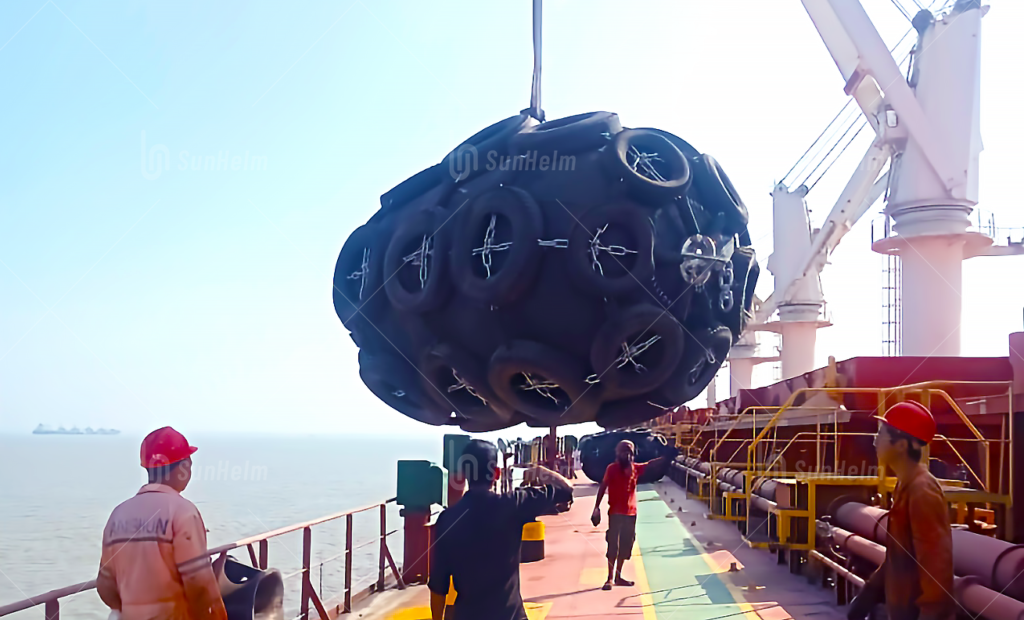When choosing pneumatic fenders for ship-to-ship (STS) transfer, oil terminals, or offshore mooring, many buyers assume that 80 kPa pneumatic fenders always perform better than 50 kPa models. It sounds logical—higher pressure, stronger performance, better protection, right?
Not necessarily. While 80 kPa pneumatic rubber fenders deliver higher energy absorption per unit size and handle rougher sea conditions, they’re not automatically the best choice. The right solution depends on vessel size, hull pressure limits, berthing energy, and operating environment.
At Sunhelmmarine, we’ve helped hundreds of operators, ports, and shipyards choose the right pneumatic fenders based on their exact scenarios. Let’s break it down.

What “80 kPa” Really Means
The “80 kPa” label refers to the internal inflation pressure at which a fender is designed to work under ISO 17357-1 standards. Here’s why it matters:
- At 60% deflection, an 80 kPa fender absorbs more energy than a 50 kPa pneumatic fender of the same size.
- However, reaction force—the push-back force applied to the vessel hull—is also much higher at 80 kPa.
- Higher reaction forces can exceed hull pressure limits, especially for lighter or coated vessels.
So, 80 kPa doesn’t automatically mean “safer.” It just means “stronger under compression.”
50 kPa vs 80 kPa: Quick Comparison
| Feature | 50 kPa Pneumatic Fender | 80 kPa Pneumatic Fender |
|---|---|---|
| Energy absorption | Good, but lower | Higher at the same size |
| Reaction force | Lower, gentler on hulls | Significantly higher |
| Fender size | Larger diameter needed for same energy | Smaller for same energy |
| Best use cases | Coastal ports, calm STS, sensitive hulls | Offshore STS, rough seas, VLCCs, LNG |
| Cost | More economical | Generally more expensive |
| Hull pressure | Safer for aluminum/yacht hulls | Higher hull stress |
| Standards | ISO 17357-1 compliant | ISO 17357-1 compliant |
When 80 kPa Pneumatic Fenders Make Sense
In some environments, 80 kPa pneumatic rubber fenders are the smarter choice:
- Offshore STS transfers in open seas where waves, swell, and currents create dynamic berthing forces.
- LNG and VLCC operations where massive energy absorption is required.
- FPSO tandem mooring where standoff distance is limited, but high energy absorption is non-negotiable.
- Ports with limited berth space that need smaller-diameter pneumatic fenders to achieve the same energy capacity.
When 50 kPa Pneumatic Fenders Are Better
Sometimes, higher pressure isn’t worth the trade-offs:
- Calmer coastal berths where environmental forces are moderate.
- Sensitive hull coatings on naval ships, aluminum craft, or luxury yachts where low hull pressure is critical.
- Budget-focused projects where maximizing cost efficiency is more important than compact size.
For many operators, 50 kPa pneumatic fenders strike the right balance between performance, cost, and hull protection.
Other Factors That Actually Decide Fender Performance
Internal pressure isn’t the only thing that matters. When Sunhelmmarine helps clients select pneumatic rubber fenders, we analyze these seven key factors:
- Energy profile – vessel displacement, approach velocity, and environmental forces.
- Allowable hull pressure – based on ship type and coating protection.
- Fender size & grade – diameter/length directly affect energy absorption.
- Netting type – chain & tire net (CTN) vs sling-type, depending on abrasion risks.
- Temperature & climate – low temperatures can affect internal pressure stability.
- Operational profile – frequency of berthing, offshore vs sheltered conditions.
- Inspection & maintenance – valves, inflation checks, and repairability.
ISO 17357-1 Standards: Why They Matter
Whether you choose 50 kPa or 80 kPa pneumatic fenders, ensure they’re certified to ISO 17357-1:
- Guaranteed performance curves for energy absorption and reaction force.
- Pressure and leak tests at the factory.
- Traceable material quality and type-approval documentation.
At Sunhelmmarine, every pneumatic fender we supply comes with full ISO-compliant test reports.
Real-World Case Examples
- VLCC-to-VLCC STS Transfer – A client in West Africa selected 80 kPa pneumatic fenders to withstand 3m swells and high approach speeds.
- LNG Terminal – 80 kPa fenders were chosen to control standoff distances and handle higher berthing energy safely.
- Container Berth in Singapore – The operator opted for 50 kPa pneumatic fenders with larger diameters to reduce hull stress on sensitive coatings.
Sunhelmmarine: Your Trusted Fender Partner
Choosing between 50 kPa and 80 kPa pneumatic fenders isn’t just about specs—it’s about engineering. At Sunhelmmarine, we provide:
- Scenario-based fender selection using real-world calculations.
- ISO 17357-1 certified pneumatic rubber fenders in both 50 kPa and 80 kPa designs.
- Custom CTN netting, safety valves, hydro-pneumatic fenders, and accessories.
- Global delivery & onsite commissioning support.
Whether you need floating pneumatic fenders for STS transfer or heavy-duty offshore mooring, we’ll help you make the right choice.
Final Thoughts
80 kPa pneumatic fenders offer compact size and superior energy absorption, but they’re not always the best option. If your operation involves sensitive hull coatings, calm berthing conditions, or budget limits, 50 kPa pneumatic rubber fenders may be a better fit.
The safest approach? Evaluate your vessel size, berthing energy, environmental forces, and hull pressure limits—then select the fender that meets all of them, not just internal pressure.
FAQs About Pneumatic Fenders
1. Do 80 kPa pneumatic fenders always last longer than 50 kPa models?
Not necessarily. Durability depends more on material quality, UV resistance, and maintenance, not just pressure rating.
2. Are 80 kPa pneumatic rubber fenders safer?
They can handle higher energy, but they also create higher reaction forces. For vessels with sensitive coatings, 50 kPa fenders may be safer.
3. Can I use floating pneumatic fenders for both STS and port berthing?
Yes. Floating pneumatic fenders are versatile and suitable for both STS transfer and fixed berths—just make sure you select the right size and pressure grade.
4. How often should I check the inflation pressure?
We recommend checking once a week during heavy STS operations and once a month for static berth use. Proper pressure maintenance extends service life.
5. Can I switch a 50 kPa pneumatic fender to 80 kPa by inflating it more?
No. The design, reinforcement layers, and ISO rating are different. Over-inflating a 50 kPa fender can cause structural damage and safety risks.


